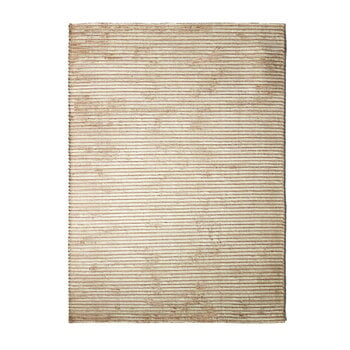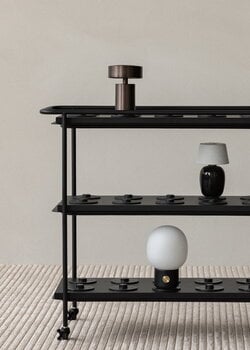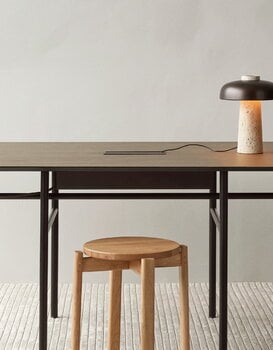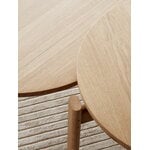Audo Copenhagen’s Houkime rug is characterised by a ribbed pattern formed by straight lines and a soft, tactile texture. Designed by Nina Bruun, the Houkime rug is woven from wood fibre Tencel and cotton, resulting in a pleasantly smooth finish with a beautiful shine. The simplistic, subtly coloured Houkime rug will find its place, for instance, on the living room or bedroom floor.
Houkime rug, 170 x 240 cm, beige
Audo Copenhagen
Description
Audo Copenhagen’s Houkime rug is characterised by a ribbed pattern formed by straight lines and a soft, tactile texture. Designed by Nina Bruun, the Houkime rug is woven from wood fibre Tencel and cotton, resulting in a pleasantly smooth finish with a beautiful shine. The simplistic, subtly coloured Houkime rug will find its place, for instance, on the living room or bedroom floor.
Product details (7)
- Material
- 75% Tencel (lyocell), 25% cotton
- Colour
- Beige
- Length
- 94.49 in (240 cm)
- Width
- 66.93 in (170 cm)
- Weight
- 37.48 lbs (17 kg)
- Notes
- Avoid using in damp areas, such as basements, bathrooms and kitchens.
- Care instructions
- Do not dry clean. Occasional professional rug cleaning is recommended.
- Product ID
Designer
Nina Bruun is a Danish design professional with experience in product and graphic design as well as being a consultant through her own business Nina Bruun Creative Consultancy. For her work the Royal Danish Academy of Design graduate has received a Red Dot Design Award, among other prizes. Her work has also been accepted in the permanent collection of MoMA in New York.
View all productsReviews (0)
Sustainability
The Product Sustainability Framework, our criteria of sustainable design, helps you find the most sustainable products in our selection. Read below which sustainability criteria this product has met.
Working conditions & labour 7/9
-
Equal opportunities for all employees
-
Commitment to UN Global Compact, fair compensation for all employees
-
Corporate responsibility requirements defined and communicated for suppliers
-
Systematic work for improved inclusion and well-being in the workplace
-
Transparent supply chain
-
Suppliers' compliance to a code of conduct ensured
-
Compliance to the UN Guiding Principles on Business and Human Rights ensured in the supply chain
-
Direct suppliers audited and certified
-
Support for community involvement in the supply chain
Eco-friendly production 8/9
-
Fair and resource-wise water-use in production
-
No incineration or landfilling of returned items
-
No use of endangered species as materials
-
No direct environmental emissions or waste (excl. GHGs) from production
-
The sustainability of direct suppliers' production is addressed and monitored
-
Production and material sourcing that respect biodiversity, animal rights, and natural ecosystems
-
Material-efficient and ecological packaging
-
No potentially harmful chemicals used in own production
-
Positive impact on nature’s well-being through operations that regenerate natural ecosystems
Climate impact 4/8
-
Company's direct greenhouse gas emissions identified and commitment to reduction
-
Product's carbon impact identified and commitment to reduction
-
Guidance on energy- and eco-efficient use of the product
-
Carbon footprint of the product calculated and goals set to reduce it
-
Contribution to climate initiatives beyond the brand’s direct operations
-
Low-carbon or compensated transportation
-
100 % renewable energy in own production and operations
-
Carbon neutral or carbon negative product
Sustainable materials 6/6
-
Sustainable and long-lasting material choices
-
No harmful or hazardous substances
-
Responsible raw material sourcing and production
-
Materials suited for circularity: monomaterials, recyclable finishings, renewable or recycled contents etc.
-
Ecological materials: natural, biodegradable, recyclable or recycled contents
-
Outstanding materials in terms of innovativeness, responsibility, sustainability and circularity: local production or sourcing, 100 % recycled content, C2C-certification etc.
Circular design 4/5
-
High aesthetic quality promoting long-term use of the product
-
Technically durable product design and material choices
-
Design for enduring life-long quality
-
Design and support for product maintenance, repair and upgradability
-
Innovative circular design solutions: circular service system, resale platform, remanufacturing, collection of used products, etc.






























